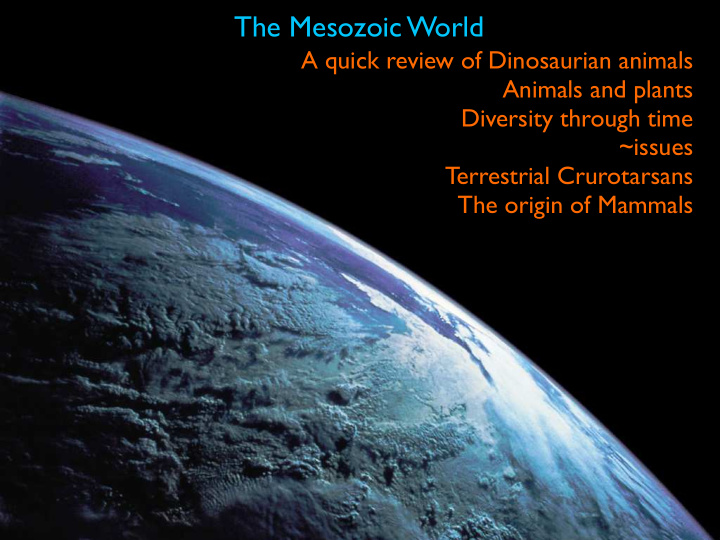



The Mesozoic World A quick review of Dinosaurian animals Animals and plants Diversity through time ~issues Terrestrial Crurotarsans The origin of Mammals
Some early terrestrial archosaurs in the Triassic... remember these guys? Rhyncosaurs early Triassic VERY abundant Terrestrisuchus Herbivorous Rauisuchians Saltoposuchus Proterosuchus Basal Archosaur
Ornithischians!
Thyreophorans: Stegosaurs & Ankylosaurs Scelidosaurus 13 ft long Gastonia Early Jurassic, England Clever girl... One meter Stegosaurus Kanyesaurus westicus
Ceropoda: Marginocephalia: Pachycephalosaurs Homalocephale earlier ‘flat’ derived Stegoceras ‘round’
Ceropoda: Marginocephalia: Ceratopsia Centrosaurs Chasmosaurs
Ceropoda: Ornithopoda Camptosaurus Shantungosaurus Corythosaurus Tenontosaurus Iguanodon Dryosaurus (small) Heterodontosaurus (small)
Saurischians!
Sauropodamorpha Coloradisaurus Prosauropod Brachiosaurus Titanosaurs Barosaurus Diplodocid
Non-avian Theropods Ceratosaurus Sinvenator Struthiomimus; Late Cretaceous Giganotosaurus; Late Cretaceous South America N. America 4.3 meters (14 ft) long 16 meters (52 ft) long
Bird-like non-avian Theropods Microraptor Mahakala
Avian Theropods Archaeopteryx Frigate Bird Raven
Pterosaurs!
Marine reptiles! Mosasaurs Plesiosaurs Ichthyosaurs Pliosaurs
Big scale questions: Biogeography When/How did dinosaurs originate? How does diversity change through time? Are there spatial patterns among dinosaur groups? Are there temporal patterns among dinosaur groups? Ecology Are there correlations between groups? Dinosaurs + plants?
When/How did dinosaurs originate? 245 to 230 Ma Silesauridae Dinosauria Asilisaurus ? Asilisaurus Morganucodon
When/How did dinosaurs originate? This is something that we’ve talked about a lot! Competitive Replacement Opportunistic Replacement
Late Triassic: 228-200 Ma Climate-Tectonics: Supercontinent at start of Triassic Warm Climate Ice Caps gone Uniform Temperature gradients Red bed and evaporites suggest continued drying Plants: Lycophytes (oldest living vascular plants) Fern ground cover Conifers and Tree Ferns dominated forests Cycads and Ginkgoes appear
Late Triassic: 228-200 Ma In addition: archaic archosaurs and therapsids remain important + first mammals, turtles, ichthyosaurs (long), pterosaurs (small), nothosaurs, placodonts Coelophysis Plateosaurus Pisanosaurus Sauropodamorpha
Late Triassic: 228-200 Ma • The Triassic is remarkable because there is very little Endemism among flora and fauna: The Pangaea Effect • Endemism: when faunas are restricted to a certain geographic range • Increases in diversity typically follow increases in endemism. Why?
Late Triassic: 228-200 Ma Staurikosaurus (Theropod) vs. a Rhyncosaur in the late Triassic
Jurassic: 200-146 Ma Climate-Tectonics: Warm, equable climate (fewer temp. swings as oceans form) Continents routinely flooded Extensive rifting and volcanism North Atlantic opens Sea levels higher (little, if any, permanent ice) Plants: Lush jungles covered the planet Confers were the primary tall trees Cycads, Ginkgoes (northern hemisphere) Ferns were the dominant undergrowth
In addition: mammals (nocturnal insectivores), lizards & amphibians (daytime insectivores, ichthyosaurs (long), pterosaurs (small), plesiosaurs, first birds
Jurassic: 200-146 Ma • Dinosaurs are the dominant terrestrial vertebrates • Small mammals, pterosaurs, and newly evolved crocodilians share the landscape • Pangaea had not ‘unzipped’. Therefore, there was little endemism represented in terrestrial biota
Jurassic: 200-146 Ma • The middle Jurassic is not well known • This is primarily the result of bias in the fossil record (few sediments formed)... not because there were no Dinos! • End Jurassic characterized by ecosystems becoming isolated: DIVERSITY and ENDEMISM increase! • Sauropods and Stegosaurs are the dominant herbivores
Cretaceous: 146-65.5 Ma Climate-Tectonics: Equable climate, but some emerging seasonality Continued rifting, volcanism, inland seas Increased CO 2 , increased greenhouse environment Development of the Southern Atlantic Complete unzipping of Pangaea Plants: Cycads, ginkgoes and ferns in decline Angiosperms take over the understory Conifers remain dominant, but their ranges become more restricted as angiosperms continue to flourish
In addition: mammals (nocturnal insectivores), lizards & amphibians (daytime insectivores, ichthyosaurs (fish-like), pterosaurs (large), plesiosaurs, small diversity of birds
Cretaceous: 146-65.5 Ma • Continued increase in Endemism as Pangaea separates • Early Cretaceous: rise of Ornithopods • Ankylosaurs and Ceratopsians become dominant herbivores • ~ note the success of the ‘chewers’... • Troodontids and Dromaeosaurs explode in diversity
Cretaceous: 146-65.5 Ma • Late Cretaceous: the most diverse time for dinosaurs • Tyrannosaurs • Pachycephalosaur explosion • This diversity does not seem to be the result of climate... no severe or sudden climate changes during this time (endemism) • Southern continents: sauropods, ornithopods, ankylosaurs, & Ceratosaur theropods (Jurassic- Style) • Northern continents: Pachycephalosaurs, Ceratopsians & Hadrosaurids
Recommend
More recommend